A little tweak ….
The other day the Hackintosh HP100 got a nice performance boost when the boot+applications SSD was upgraded from SATA2 to SATA3. Fast disk I/O is essential for best Lightroom and Photoshop performance. Now it’s the CPU’s turn.
Geekbench is a test of CPU speed. It’s a simple and quick comparator of great use to photographers as apps like Photoshop and Lightroom are far more dependent on CPU speed than on the latest in GPUs. Little is to be gained, data suggest, from using a high-end gaming GPU.
Cinebench framing rates are a measure of GPU speed. My Hackintosh HP100 (Sandy Bridge Core i5, 16gB RAM) uses a three year old, low power draw, Nvidia 9800GTX+ GPU, yet returns a very high Cinebench framing rate.
One of the beauties of the Sandy Bridge and later Ivy Bridge CPUs is that overclocking is trivially simple, unless you go crazy. Clock speed is a near-linear indicator of effective speed for like CPUs. Double the clock speed and you should see an almost identical change in the Geebench score. In summary, the Sandy Bridge i5-2500K overclocks from 3.3gHz stock to 4.4gHz with one key entry in the BIOS. The i7-2600K goes from 3.4gHz to 4.5gHz for the same effort. As long as you dispense with the inept stock Intel fan and fit a Coolermaster 212 ($27) or similar, you will be thermally protected. Further, the BIOS has many failsafes to turn things off if heat rises too much.
I have been running my Sandy Bridge i5 at 4.0gHz since inception, or 21% over the 3.3gHz stock, but the new Geekbench Ivy Bridge data for the just released MacBook Pros spurred me to action. Here are those data:
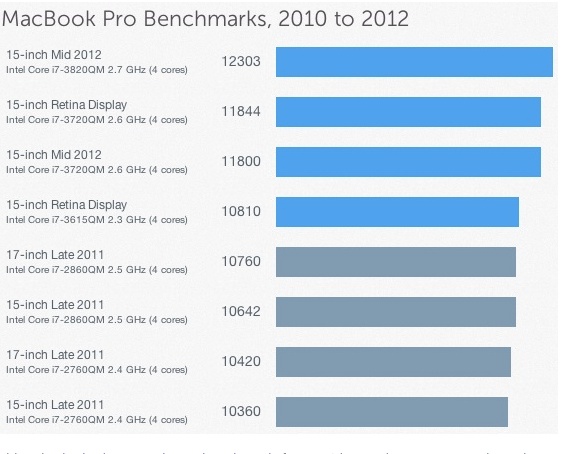
Meanwhile, HP100, perking along at 4.0gHz, records the following in Geekbench 64:
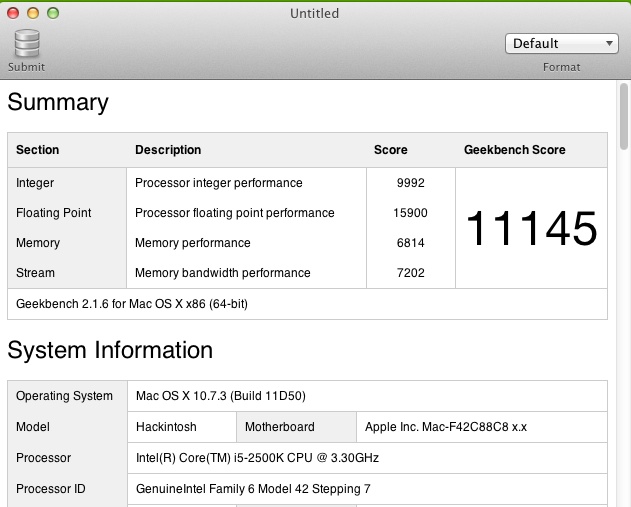
Actual speed with several apps running. 4.0gHz is correct, GB states it incorrectly.
Hmmm. Not good enough, even if my environment measures ‘real world’ results with Mail, Finder, Safari, Firefox, etc. running. You can also bet that the above MacPro data are in an ideal setting with no other apps running. That’s how Apple does data.
So I hopped into the BIOS on the Gigabyte motherboard, changed the ‘Frequency Multiplier’ from 40x to 44x, meaning the clock speed is now 4.4gHz, and restarted. Two minutes later I had the following result:
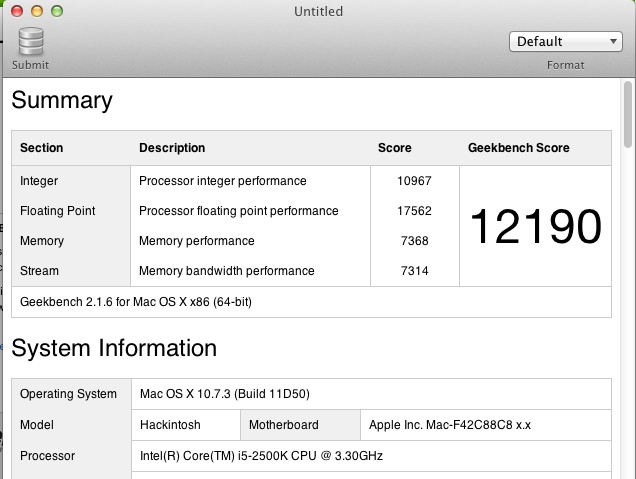
Core i5 Sandy Bridge at 4.4gHz. 42% faster than stock.
That’s more like it. A 10% clock frequency increase realizes a 9.4% CPU speed gain, and equalling the fastest, latest and greatest from Apple, at no incremental cost to me.
Heat, that bugbear of all computers, remains unchanged.
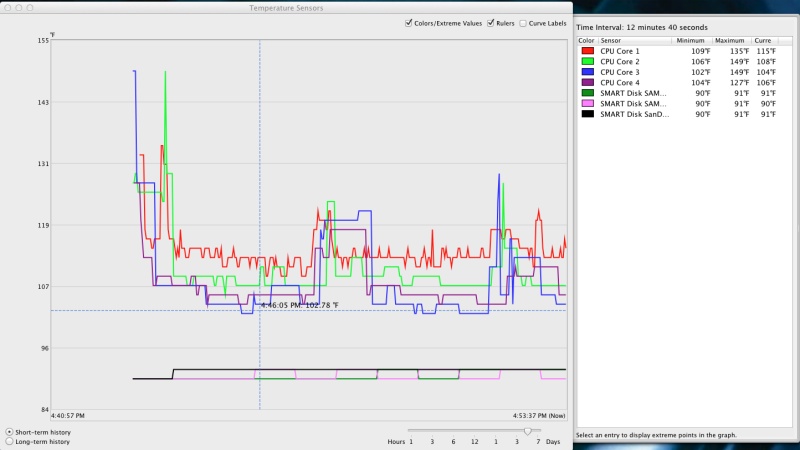
Temperature graph at 4.4gHz.
The above graph reports the temperature of the four CPU cores from restart. The usual start-up spike quickly disappears to settle at 109F, indistinguishable from the reading at 4.0gHz. The CPU cooler is set in BIOS as a variable speed device, meaning it cranks up only when needed. It sounds just a little louder than at 4.0, meaning it’s working harder but just as effectively. On the other hand, when I was running this test, ambient temperature was a high 85F (we have no air conditioning as it rarely gets that warm in the SF Bay Area) so there’s little to worry about. Things can only get cooler on regular days. The spike toward the right results from starting Lightroom 4. Starting Photoshop CS5 does not make any discernible difference. I have had no stability issues so far.
The Cinebench tests for GPU speed are outstanding. Brown (#5) is for HP100 at 4.0gHz, Orange (#4) is at 4.4gHz (not 4.0 as shown) – 13.3% faster. The highest reading here (#1) is for a Xeon equipped machine with a high end gaming GPU – meaning $1,400 more for the CPU and $1,300 more for the GPU – for a 25% speed increase. Goodness, the all in cost of HP100 is less than one of those components! And PS and LR do a very poor job of multi-threading so a 12 thread CPU is money wasted. Those economics do not solve for me nor does any photographer need to spend that sort of money. #3 is for HP100 running at stock GPU speed but with all other apps closed – hardly realistic, but impressive if you are a marketer. Marketing, after all, is lying for a living.
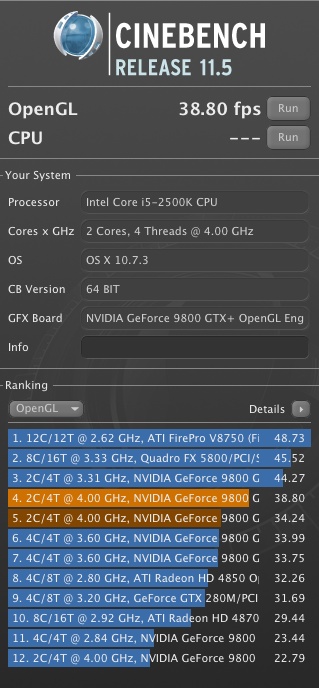
GPU results from Cinebench.
And when Apple gets faster, you can bet on one thing. With a tweak or two, HP100 will be right there at very little or zero cost.
Looking forward:
If you accept that CPU speed increases are leveling off, and that the focus will increasingly be on lowering power consumption, then simply dropping an i7 in place of the i5 will yield a 25-30% speed increase, for a net upgrade cost of maybe $150 after reselling your i5. I doubt Intel will be able to increase its CPUs’ speeds by more than 5% annually henceforth.
GPUs are already so far ahead of anything photographers need that spending lavishly here makes little sense. Any conceivable pixel density is already supported.
In the case of both, Adobe’s software is a long way behind what the hardware can do. Poor use of multi-core, multi-threading technologies means that far greater gains are to be had from software design than from hardware upgrades. Lightroom, in particular, is showing massive code bloat, with no improvement in operating speed. LR4 is some ten times the size of LR3.
The next frontier is peripheral I/O, where Intel’s LightPeak (we keep hearing that Apple’s Thunderbolt is the latest invention from Cupertino, when in reality it is simply LightPeak on which Apple’s 1 year wasted exclusive has now expired). LightPeak promises disk read/writes ten time faster than USB2, maybe three times faster than USB3. Whether it succeeds like USB2 did, or fails like Firewire has, remains to be seen. Very slow adoption is not encouraging, and I suspect it’s simply not a mass-market selling point. External drives are hardly the norm in the average home. If it does succeed, you can bet cheap PCIe cards will become available and that photographers’ Hackintoshes will be adding these for a few dollars.
Update:
As I’m not about to be beaten by Apple’s poor hardware, I set about adding a little more fire to the pot by tweaking the i5’s frequency multiplier from 44x to 45x, for a CPU frequency of 4.5gHz, and increased the VCore voltage to 1.385volts for stability. Nothing else was changed. System ambient temperature remains at 113F (45C) and is stable. At stock VCore it kernel panics. Intel specifies the maximum safe VCore at 1.52 volts so it’s not like I’m really puashing it here. This is the result – faster than the Core i7 in the fastest MacBook Pro:
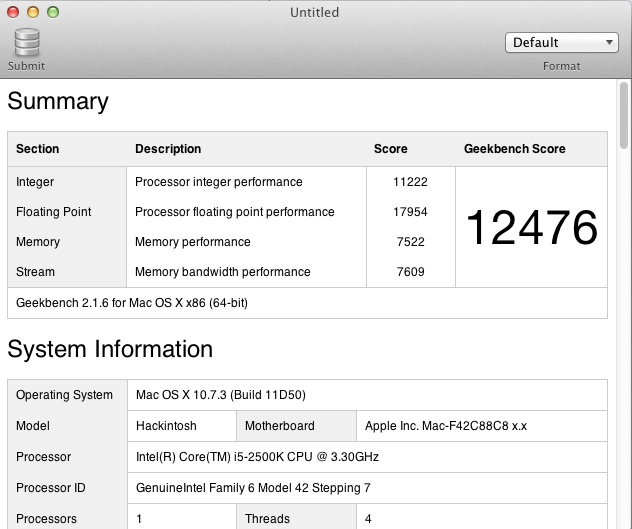
Intel Core i5 – 2500K at 4.5gHz CPU speed.
1.4% faster than the fastest MacBook Pro, with more to come.
Cinebench GPU data remain unchanged.
I have shutdown failsafes in the BIOS set at a CPU temperature of 176F (190F is the danger point for the i5 2500K) so everything remains conservatively specified.
These data suggest that a modestly overclocked i7 – 2600K Sandy Bridge should be good for 16,000 or more. But you do need proper cooling to do this sort of thing, not Intel’s stock cooler.
The Z68 chipset on the motherboard does not work happily with OS 10.7.4, and while there are workarounds, it’s not worth the effort. (It slows to a crawl). H67 and P67 chipsets have no issues with 10.7.4. So on the HP100 I’m sticking with 10.7.3 for now. Only P and Z motherboards support overclocking.
Another 25% in speed?
Sure. Get a Core i7-2600k. Look here.